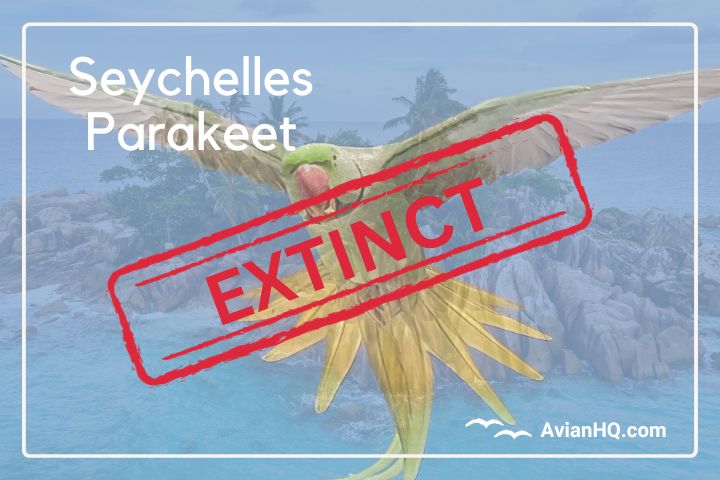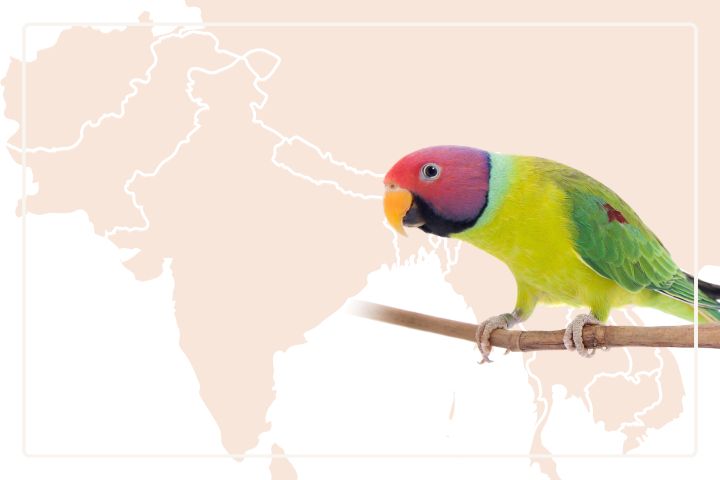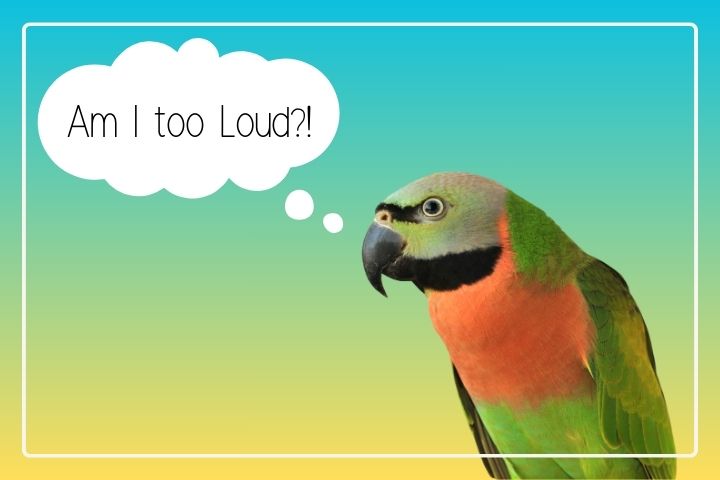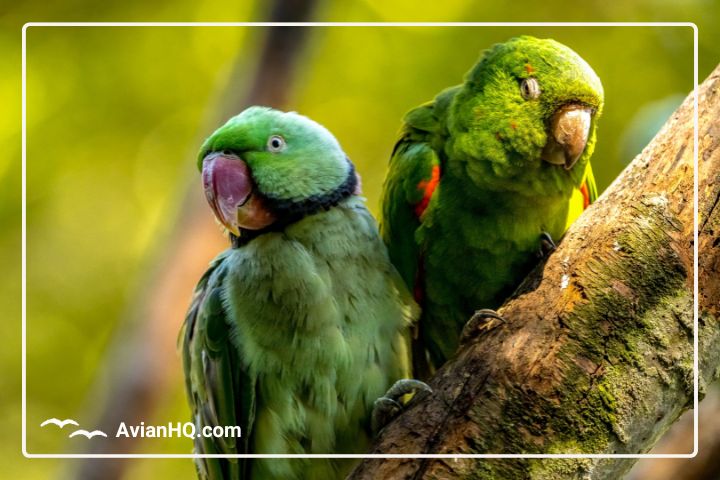Seychelles Parakeet (Psittacula wardi)
The Seychelles Parakeet (Psittacula wardi) was a beautiful green parrot native to the Seychelles islands in the Indian Ocean. As its common name suggests, this vibrant bird was endemic to the Seychelles, found nowhere else in the world. Tragically, despite its beauty and uniqueness, the Seychelles Parakeet eventually went extinct in the early 20th century due to a combination of human activity and predation by invasive species.
In this blog post, we will comprehensively cover the natural history of the Seychelles Parakeet – from its origins and physical appearance, to its habitat, distribution, diet, and eventual demise. We will analyze the leading theories behind the extinction of this species, as well as past conservation efforts that sadly could not save the parakeet from its fate. Additionally, we will reflect on the significance and legacy of the Seychelles Parakeet, and what its loss means for the fragile island ecosystem it once inhabited.
Our goal is to provide a detailed profile of this extinct bird and memorialize it for current and future generations. The story of the Seychelles Parakeet offers sobering lessons about the devastating impacts of invasive species, habitat destruction, and the existential threat human activity can pose to vulnerable island species with limited ranges. By learning about extinct animals like the Seychelles Parakeet, we hope to inspire greater stewardship of the living creatures with whom we share this planet.
History of the Seychelles Parakeet
The Seychelles Parakeet was first scientifically described in 1883 by the Austrian ornithologist Gustav Hartlaub, who named the species Psittacula wardi after the British ornithologist and bird collector Guy Ward. Prior to this formal classification, the parakeet was known locally by the French name “perroquet des Seychelles.”
Early accounts indicate that the Seychelles Parakeet was once relatively widespread and abundant across the Seychelles islands. It inhabited at least eight of the islands within the Seychelles archipelago, with the main populations centered on the islands of Marianne, Frégate, and Denis. Estimates from the late 1800s suggest that the total population numbered in the hundreds or low thousands.
Unfortunately, the population of the Seychelles Parakeet steadily declined over the ensuing decades. By the early 1900s, it had disappeared from several of the islands it previously inhabited. Hunting and trapping of the birds for food, trade, and feathers contributed to its plummeting numbers. Predation by invasive species also severely impacted the vulnerable parakeets.
The last confirmed sighting of a Seychelles Parakeet was documented in 1906 on the island of Frégate. Just two decades after its scientific discovery, this beautiful parakeet had quietly blinked out of existence, the victim of extensive habitat loss and human exploitation. The brightly-plumed Seychelles Parakeet survives today only as museum specimens and written records – a cautionary tale of an endemic island species driven to extinction.
Physical Appearance of the Seychelles Parakeet
The Seychelles Parakeet was a medium-sized, slender parakeet measuring approximately 38-41 cm (15-16 in) in length. Its tail accounted for about half its total length, at around 18 cm (7 in). The parakeet had a wingspan of 20.5 cm (8 in) and weighed 90-110 g (3.2-3.9 oz).
| Measurement | Size |
|---|---|
| Total length | 38-41 cm (15-16 in) |
| Tail length | 18 cm (7 in) |
| Wingspan | 20.5 cm (8 in) |
| Weight | 90-110 g (3.2-3.9 oz) |
Adult Seychelles Parakeets exhibited prominent sexual dimorphism in their plumage. Males had bright green feathers covering their heads, backs, wings, and undersides. Their tails were bluish-green in color. Females were duller in appearance, with olive-brown plumage on the head, wings, back and breast, contrasting with a brighter green lower belly and thighs. Both sexes had distinctive crimson patches on their shoulders. Their eyes were orange-red with pale grey eye-rings, and their beaks were pale horn colored. Juveniles resembled adult females but with darker eye coloration.
In flight, the parakeet’s pointed wings, long tail, and rapid wingbeats gave it an agile and swift appearance. Its feathers had a distinctive scalloping pattern that differentiated it from other parrot species inhabiting the Seychelles islands. The parakeet’s bright plumage and unique scalloped feathers made it visually distinctive and attractive.
Habitat and Distribution
The Seychelles Parakeet was endemic to the Seychelles archipelago in the Indian Ocean, located northeast of Madagascar. This island nation is comprised of 155 islands, though the parakeet primarily inhabited the granitic inner islands.
Its natural habitat consisted of coastal plains, palm groves, and wooded valleys located at elevations up to 500 meters. It occupied a range of forest types, including palm forests, sand-dune vegetation, marsh forests, and gardens. The parakeet nested in holes in trees, especially palms.
Originally, the Seychelles Parakeet inhabited at least eight islands in the archipelago: Marianne, Frégate, Denis, North, Cousin, Cousine, Long, and Aride. However, it disappeared from several of these islands in the late 1800s as its population declined. By 1890, it was mainly confined to Marianne, Frégate, and Denis Islands. After 1900, the sole remaining population was on Frégate until its extinction in 1906.
The parakeet’s restriction to these inner granitic islands, and its absence from the coralline outer islands, suggests it was limited by available habitat and food resources. Its extinction underscores the vulnerability of island endemics with small, fragmented distributions to external threats.
Diet of the Seychelles Parakeet
The Seychelles Parakeet was herbivorous and frugivorous (feeds primarily on fruit), feeding on a variety of fruits, seeds, nuts, and other plant material.
Some key food sources included:
- Fruits – guavas, palm fruits, tamarinds
- Seeds – clove, coconut
- Nectar – bottlebrush and coral trees
The parakeet’s strong curved beak was adapted for cracking hard nuts and seeds. Their diet likely varied seasonally based on food availability.
“The parakeet fed on guavas and a variety of seeds, using its specialized beak to access hard nuts and fruits.”
The Seychelles Parakeet foraged for food in small flocks, often seen clambering along branches and hanging upside down to reach fruit and flowers. Pairs shared food during courtship feeding.
They employed a range of feeding behaviors and strategies:
- Foraging through dense foliage with their beaks
- Plucking fruits directly from trees
- Cracking open hard nuts and seeds
- Licking/lapping nectar from flowers
- Regurgitating food to feed young
- Storing seeds and nuts in throat pouches
Their specialized frugivorous/granivorous diet meant the parakeet likely played a key role in seed dispersal and pollination in its island ecosystems through their foraging and feeding behaviors.
Extinction Theories
The extinction of the Seychelles Parakeet was likely caused by a combination of factors that led to its rapidly dwindling population in the late 19th and early 20th centuries. Scientists have proposed several possible contributing extinction drivers:
Predation by Invasive Species
The introduction of non-native species to the Seychelles is believed to have put substantial predatory pressure on the parakeets:
- Rats – accidentally introduced in 1770s, predated eggs and nestlings
- Cats – introduced in 1840s, preyed on adult parakeets
- Mongooses – introduced in 1900 to control rats, but attacked birds
“Predation by invasive mammals such as rats, cats, and mongooses is strongly implicated in the parakeet’s extinction.”
With restricted island habitats, the parakeet had limited ability to escape these exotic predators. Its nests and roost sites were highly vulnerable.
Habitat Loss and Degradation
Deforestation and land clearing on the islands caused substantial habitat loss:
- Forests logged for timber starting in 1770s
- Palm trees felled for coconuts as cash crop
- Agricultural development and fires destroying native habitat
This degraded the parakeet’s nesting sites and depleted its food sources. Fragmentation likely further limited its ability to forage and breed successfully.
Overhunting and Trapping
Extensive hunting of the parakeets also contributed to declining numbers:
- Hunted for food by early settlers
- Trapped as pets or for trade
- Feathers used for decorations and status symbols
Lack of hunting regulations allowed uncontrolled exploitation of the species.
Climate Factors
Shifting weather patterns and climatic events may have also played a role:
- Droughts limiting food availability
- Storms destroying nest sites
- Long-term habitat changes
However the climate impact is less clear than other threats.
Disease
No diseases are specifically documented, but introduction of avian diseases from imported species was possible. Inbreeding depression from small population size could have also impacted immunity.
Combined Threats
The parakeet faced a barrage of threats – invasive species, habitat loss, overhunting, climate shifts, and disease. The small population size and limited distribution of this island endemic made it highly vulnerable to these extinction drivers. The combined impact of multiple factors likely sealed its fate.
Conservation Efforts of the Seychelles Parakeet
Unfortunately, conservation efforts to save the Seychelles Parakeet were too little, too late. By the time substantial measures were put in place to protect the species in the late 1890s and early 1900s, its population was too small and depleted to recover.
Legal Protections
Legal protections for the parakeet were enacted in 1899, with the species classified as protected. This made killing or capturing parakeets illegal. However, actual enforcement of these new laws was likely sparse and ineffective. Trapping and trade of the birds continued apace despite formal legal status. Four years later in 1903, another law was passed specifically banning the killing of Seychelles Parakeets, but again, enforcement and implementation lagged.
Captive Breeding
A small number of parakeets were captured from the wild in the early 1900s in hopes of establishing a captive breeding population. Conservationists at the time understood that protective measures were needed to save the rapidly declining species. However, they failed to sustain a viable captive flock. Husbandry practices for parakeets were relatively primitive, and the limited founder population meant capacity for maintaining genetic diversity was low. No successful reintroduction of captive parakeets to the wild ever occurred.
In the latter part of the 20th century, well after the extinction of the species, protected wildlife areas were established that encompassed some of the parakeet’s former habitat. Praslin National Park was created in 1979 and Vallée de Mai Nature Reserve in 1985. But these conservation sites could not undo the habitat loss and degradation that contributed to the parakeet’s demise many decades prior.
In the end, conservation efforts for the Seychelles Parakeet were hampered by minimal resources, limited technical knowledge of the time, sparse legal protections enacted too late, and failure to effectively curb ongoing threats. The loss of this parakeet underscored how difficult reversing extinction trajectories could be in practice, especially with delayed or minimal interventions.
Significance and Legacy of the Seychelles Parakeet
The extinct Seychelles Parakeet held several important roles both ecologically and culturally. The loss of this endemic island species had significant impacts that echo to this day.
Ecological Role
As a frugivore and granivore (feeds on the seeds of plants), the parakeet contributed to seed dispersal and pollination within its island ecosystem. Its foraging behaviors helped propagate plant species that relied on the parakeet.
“The Seychelles Parakeet was a key seed disperser and pollinator in its native forests before extinction.”
It also served as prey for native Seychelles predators like the Seychelles Kestrel. Decline of the parakeet possibly impacted other species.
Cultural Symbolism
The parakeet held cultural significance in Seychelles history and tradition:
- Appeared in folklore and songs
- Depicted in decorative arts and jewelry
- Remained in national memory and identity
Its extinction represented a loss of part of Seychelles’ natural heritage.
Conservation Legacy
The demise of the species contributed to future conservation efforts:
- Catalyst for new environmental protections
- Increased focus on invasive species impacts
- Drove captive breeding initiatives for other Seychelles birds
- Symbol of extinction and fragility of island species
Lost Genetic Diversity
The parakeet’s extinction represented an irrevocable loss of unique genetic diversity:
- Endemic subspecies, found only in Seychelles
- Centuries of evolutionary history and adaptation
- Distinct niche in island ecosystem
This genetic diversity cannot be recovered.
The Seychelles Parakeet lives on as a poignant reminder of the vulnerability of island species to habitat loss and introduced predators. Its sad fate spurred increased environmental protections in the Seychelles and continues to inspire conservation today.
Conclusion
The demise of the Seychelles Parakeet represents one of the great tragedies of species extinction. In little more than two decades, this colorful parrot went from tranquilly inhabiting palm groves across a handful of Seychelles Islands, to vanishing forever from existence.
The rapid extinction of the Seychelles Parakeet was caused by an onslaught of threats including deforestation, invasive predators, uncontrolled hunting, disease, and climate shifts. Its restricted range and small population size left it vulnerable and unable to cope as human activity and introduced species upended its island home.
This beautifully plumed parakeet should still be flourishing today across the Seychelles, foraging on fruits and nuts, rearing its young in nest holes, and dispersing seeds through its native forests. But like so many island species, its future was cut short by human incursion into its delicate island ecosystem.
Though conservation efforts ultimately failed to save the species, the parakeet’s extinction helped catalyze critical habitat protections and new environmental policies in the Seychelles. This small green parrot remains an icon for the extinction crisis, emphasizing the fragility of endemic island birds and spurring preservation of those still remaining. By understanding what was lost when the Seychelles Parakeet disappeared, we can better protect parrots and other wildlife into the future.








I got what you intend,bookmarked, very decent web site.